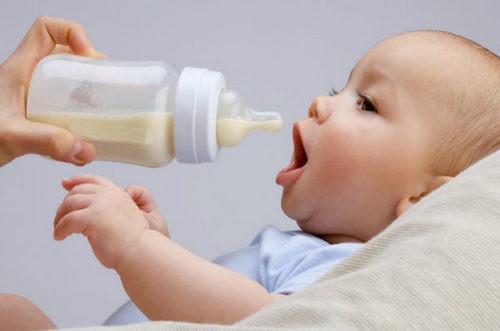Increasingly, parents observe digestive problems in their newborn babies. As a rule, adults blame low-quality products or physiological characteristics of the baby for malfunctions of the gastrointestinal tract. But often the cause of flatulence, vomiting and loss of appetite is the lack of digestibility of lactose.
This pathology involves the use of lactose-free mixtures for children as the basis of the diet.
The inability to assimilate milk sugar entails a change in the nutrition of the crumbs. Pediatricians prescribe soy or goat milk-containing mixtures for newborns with lactase deficiency. Let’s try to figure out what is their difference and how to choose the right food for the baby.
Features of lactose-free mixtures
Such food is therapeutic, therefore, it is prescribed by a doctor only after determining the exact diagnosis based on a number of tests. Milk sugars are very important for the development of the baby, so an independent decision to switch to lactose-free products can be fraught.
So, what are the features of lactose-free infant formula? Such food differs from usual in the following points:
- Usually, the doctor excludes lactose from the diet for a certain period. At the end of the next course, he must check to see if the child’s absorption of sugar is improving.
- If the baby is shown a lactose-free mixture, which parents should better decide. Soy-based products are created without non-digestible components, but in milk mixtures their traces are most often present.
- It is worth noting that the taste of nutrition without milk protein leaves much to be desired, respectively, many babies refuse it.
- Feeding with lactose-free mixtures for several months or more leads to problems with the gastrointestinal tract (possible colic, diarrhea, imbalance in the composition of the intestinal microflora).

In what cases are lactose-free mixtures necessary?
Mixtures not containing milk sugar are prescribed for children on artificial feeding, in which there are symptoms of complete or partial intolerance to lactose. In most cases, a second diagnosis is made by the pediatrician, so a full translation is not often required.
There are several feeding regimes for lactose deficiency, this determines which mixture without lactose should be acquired:
- a mixture of conventional and therapeutic mixtures;
- alternation of feeding soy and milk nutrition.
The doctor selects their ratio individually. Acute intestinal infections are also one of the reasons for the appointment of a lactose-free mixture. Immediately after a complete recovery and restoration of microflora, the usual food returns.
Secondary insufficiency due to chronic diseases of the gastrointestinal tract requires not just soy mixtures, but special medical nutrition. It slightly changed the ratio of fats and proteins. Lactose in such mixtures may be completely absent or present in small amounts.
The rarest reason for switching to medical nutrition is primary lactose deficiency. This is a genetic disorder in which lactase (the enzyme responsible for digesting lactose) is absent from the moment of birth. But in the world this diagnosis is made to no more than 40 babies.
With age, the manifestation of this feature is smoothed out. By two years, it becomes minimal. Although the symptoms of individual intolerance to milk sugars can occur at absolutely any time.
By the way, in the regions of the prosperity of dairy farming, this diagnosis is practically not made. But where there is no milk in the diet, there are quite a few cases. So, in the north of the European continent no more than five out of a hundred people are not able to digest milk, in the central regions – about 25-30.
Premature babies very often suffer from reduced lactose activity. This is due to insufficient formation of the enzyme system. But in this case, breastfeeding activates the maturation of enzymes.
What is the difference between adapted mixtures?
What is the principle of adapted mixtures? Their composition should resemble breast milk as much as possible. For this, as a rule, dairy components are used, although lactose-free mixtures in goat milk are popular. But, unlike the adapted options, milk sugars are practically or completely absent here. In therapeutic mixtures, soy is more often the main component.
The main difference is the amount of carbohydrate – lactose. It is always present in adapted diets, since sugars are found in woman’s natural milk. At the same time, vitamins and minerals in the mixture contain no less.

How to change a baby’s diet?
Lactose-free mixtures are introduced into the infant’s diet gradually. Pediatricians themselves develop a course of admission, however, several fundamental rules can be distinguished.
Instant transition to feeding without milk sugars provokes the development of constipation. For this reason, the baby is transferred to a new diet gradually.
On the first day, 30 ml of a new product is enough. By the second day, you can try to conduct a couple of feedings, in each of which 60 ml of the mixture has already been added. By the fourth day, the infant formula for lactose deficiency will be well absorbed.
The stages of the transition vary slightly depending on the physiological characteristics of the baby. During the period of replacing the mixture, it is important to control the well-being of the child, his reaction to a new type of nutrition.
Reverse transition is no less complicated process. The fact of intolerance to breast milk does not mean that a person will have to bypass the shelves with dairy products all his life. There are practically no people whose failure remains lifelong.
Over time, the baby acquires useful microorganisms, their ratio in the body normalizes. This process can be accelerated by giving mixtures with probiotics or by taking them separately, and not as part of the main feeding. But even if it seems to mother that the baby began to perceive milk components perfectly, it is better not to take risks and not switch to normal nutrition completely.
Before this, a survey should be performed that will show the absence of lactose deficiency. Only after this adapted diet in minimal doses begins to be introduced into the diet of the child.
Overview of Lactose Free Mixtures
Before introducing a new product into the diet, parents should figure out which component can be included in a lactose-free diet, which minerals and vitamins should be contained in it. To understand which lactose-free mixture is better and how they differ, consider the most popular ones:
- Nutrilon. The basis is soy protein isolate. The content of animal components is 0%. For the full development of the child, taurine and kartin are in the composition. With it, an easy transition to other options is possible, for example, the Bellact Bezlaktoznaya mixture.
- Mamex. The manufacturer achieves its resemblance to mother’s milk thanks to the optimal combination of vegetable fats. Heavy carbohydrates are replaced by maltodextrin. The mixture contains a small amount of milk sugars and proteins.
- Nutrilac. Budget option lactose-free mixtures. The main component is cow’s milk protein. Nutrilac is enriched with Omega-3 and Omega-6. Components bring food to mother’s milk as closely as possible.
- Similak Low Lactose is a specialized mixture for children with a high sensitivity to milk sugar. According to experts, the composition contains all the substances necessary for the baby contained in breast milk. There is no palm oil in the diet, which facilitates the digestion and tolerance of the components. Probiotics form the baby’s soft stool, and nucleotides help strengthen immunity. Organic acids strengthen blood vessels and improve brain activity. Similac contains all the nutrients that the baby receives through natural feeding.
- Nan Lactose-Free. The composition does not contain allergens and glucose. The main component of the mixture is corn syrup with added enzymes and probiotics. Ideal for children with low immunity. But it costs a lot.
The composition of the Nan Bezlactose-free mixture is excellent for switching to a normal diet, as it still has small amounts of lactose. Its insignificant content will determine whether the body is ready for digesting milk.

Step by step, crumbs can be transferred to the alternation of mixtures. Then the amount of lactose-free mixture is reduced to zero. As a rule, at this time the child is already growing up, and, in addition to milk formulas, receives complementary foods. If the baby calmly switched to a normal diet, it is safe to say that the adaptation is complete and the necessary microflora has normalized in the intestine.
It is important for parents to remember that you can’t decide on a baby to switch to a lactose-free diet on your own. Such mixtures are specialized medical nutrition, special care should be taken when they are introduced into the diet. After prolonged use, small microorganisms and enzymes settle in the crumbs in the intestines. Then the time comes to return to normal nutrition.
A qualified pediatrician should select the nutrition for the infant for the reason that not every child needs a mixture without milk proteins. More often, the baby needs an adapted mixture in which lactose is still there, like milk.
Which food is better – lactose-free or adapted – can only be determined by trial and error. Much depends on the individual degree of assimilation of the components by the child. In the process of introducing special mixtures, you need to analyze the reaction of the newborn’s body to food.
It is generally accepted that the diet is suitable if after 5 days the intestine has completely adopted a new diet. In the absence of gas and normal stool, the baby is ready to eat lactose-free mixtures.



